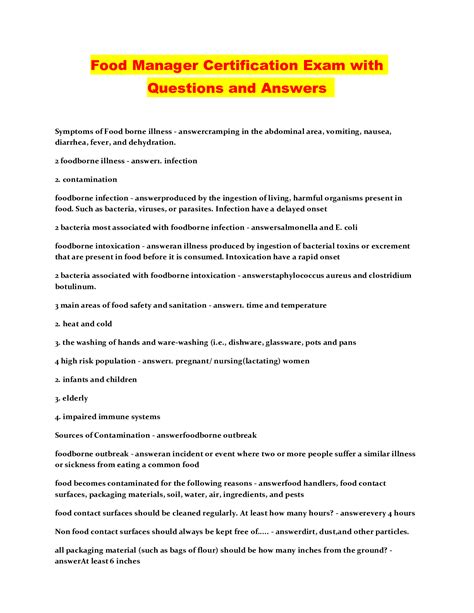Introduction

Food safety is paramount in the hospitality industry. To ensure food establishments meet the highest standards of sanitation, food managers must possess in-depth knowledge of food safety practices. Acquiring a food manager certification is a testament to one’s proficiency in food hygiene and safety regulations.
The food manager exam is a comprehensive assessment that evaluates candidates’ understanding of food safety principles. Preparing thoroughly is crucial for success on this exam. This article provides authoritative food manager exam answers that will empower you to pass with confidence.
Section 1: Foodborne Illnesses
Understanding Foodborne Illnesses:
- Around 48 million Americans contract foodborne illnesses annually (CDC, 2019).
- The economic impact of foodborne illnesses exceeds $15 billion yearly (USDA, 2018).
Common Foodborne Pathogens:
- Bacteria: Salmonella, E. coli, Campylobacter
- Viruses: Norovirus, Hepatitis A
- Parasites: Giardia, Toxoplasma gondii
Symptoms and Prevention of Foodborne Illnesses:
- Symptoms vary depending on the pathogen, ranging from mild gastrointestinal discomfort to severe dehydration and even death.
- Proper food handling, sanitation, and storage are crucial for preventing foodborne illnesses.
Section 2: Food Safety Regulations
Hazard Analysis and Critical Control Points (HACCP):
- HACCP is a systematic approach to identifying and controlling food safety hazards.
- It involves identifying critical control points (CCPs) where potential hazards can be prevented or eliminated.
Good Manufacturing Practices (GMPs):
- GMPs are guidelines established by the FDA to ensure food production meets sanitary standards.
- They include requirements for employee hygiene, equipment maintenance, and pest control.
Food Allergens:
- Food allergies affect approximately 10% of the population (FARE, 2020).
- Food establishments must be aware of allergens and provide clear labeling to prevent allergic reactions.
Section 3: Food Safety Hazards
Physical Hazards:
- Foreign objects such as glass, metal, or bone fragments
- Prevention: Metal detectors, X-ray machines, and proper food handling techniques
Chemical Hazards:
- Toxins from plants, animals, or chemicals
- Prevention: Careful food sourcing, proper storage, and thorough cooking
Biological Hazards:
- Bacteria, viruses, and parasites
- Prevention: Time and temperature controls, proper food storage, and employee hygiene
Section 4: Food Safety Practices
Food Storage and Handling:
- Refrigerate perishable foods at 41°F or below
- Store raw meat and seafood separately from other foods
- Practice FIFO (first in, first out)
Cooking and Cooling:
- Cook food to the proper internal temperature to kill bacteria
- Rapidly cool cooked foods to prevent bacterial growth
Employee Hygiene:
- Wash hands frequently with soap and water
- Wear clean clothing and head coverings
- Avoid touching food with bare hands
Section 5: Food Safety Management
Food Safety Plan:
- A written plan outlining food safety procedures and responsibilities
- Required for all licensed food establishments
Food Safety Training:
- Employees must receive training on food safety practices
- Training should be documented and regularly updated
Self-Inspection Programs:
- Regular inspections to identify and correct potential food safety hazards
- Required by many regulatory agencies
Section 6: Common Mistakes to Avoid
- Undercooking Food: Bacteria can survive and multiply if food is not cooked to the proper temperature.
- Cross-Contamination: Pathogens can spread from raw to cooked foods if proper separation and handling techniques are not followed.
- Improper Food Storage: Temperature abuse can lead to bacterial growth and spoilage.
- Poor Employee Hygiene: Employees with poor hygiene can contaminate food with bacteria and viruses.
- Lack of Food Safety Training: Untrained employees may not be aware of proper food safety practices, increasing the risk of foodborne illnesses.
Why Food Manager Certification Matters
- Enhanced Food Safety: Certified food managers have a comprehensive understanding of food safety principles, reducing the risk of foodborne illnesses in their establishments.
- Legal Compliance: Many regulatory agencies require food managers to be certified as proof of their food safety knowledge.
- Increased Customer Confidence: Customers are more likely to trust establishments with certified food managers, enhancing reputation and revenue.
- Reduced Liability: Certification demonstrates that food managers are taking steps to ensure food safety, reducing the risk of legal liability in the event of foodborne illnesses.
Table: Minimum Internal Cooking Temperatures
| Food | Internal Temperature (°F) |
|---|---|
| Poultry (e.g., chicken, turkey) | 165 |
| Ground meat (e.g., beef, pork) | 155 |
| Fish | 145 |
| Eggs | 160 |
| Pork chops | 155 |
| Ground seafood (e.g., fish, shrimp) | 165 |
Table: Foodborne Pathogen Symptoms and Sources
| Pathogen | Symptoms | Common Source |
|---|---|---|
| Salmonella | Diarrhea, vomiting, fever | Poultry, eggs, dairy |
| E. coli | Abdominal cramps, bloody diarrhea | Ground beef, unpasteurized milk |
| Campylobacter | Diarrhea, abdominal pain, fever | Poultry, unpasteurized milk |
| Norovirus | Vomiting, diarrhea, nausea | Shellfish, contaminated water |
| Hepatitis A | Fatigue, nausea, jaundice | Contaminated food or water |
Table: Food Safety Hazards and Control Measures
| Hazard | Control Measure |
|---|---|
| Physical | Metal detectors, X-ray machines |
| Chemical | Toxin screening, proper storage |
| Biological | Time and temperature controls, proper cooking |
Table: Food Safety Practices and Benefits
| Practice | Benefit |
|---|---|
| Food Storage | Prevents bacterial growth, reduces spoilage |
| Cooking | Kills bacteria, reduces foodborne illness risk |
| Employee Hygiene | Prevents contamination, promotes safe food handling |
| Food Safety Training | Improves employee knowledge, enhances food safety |
